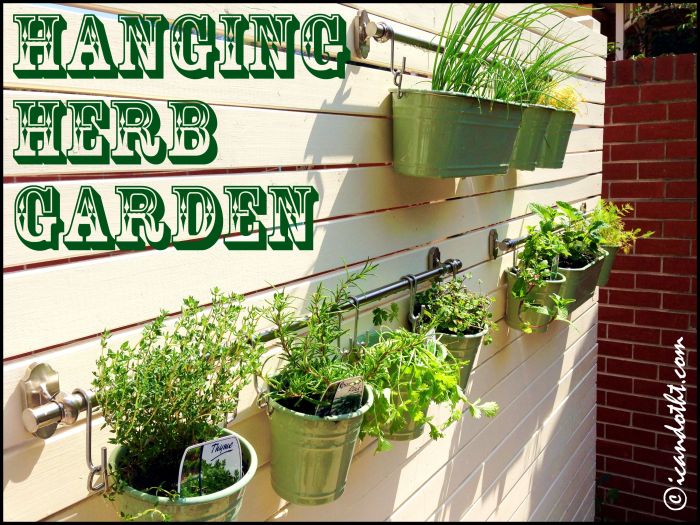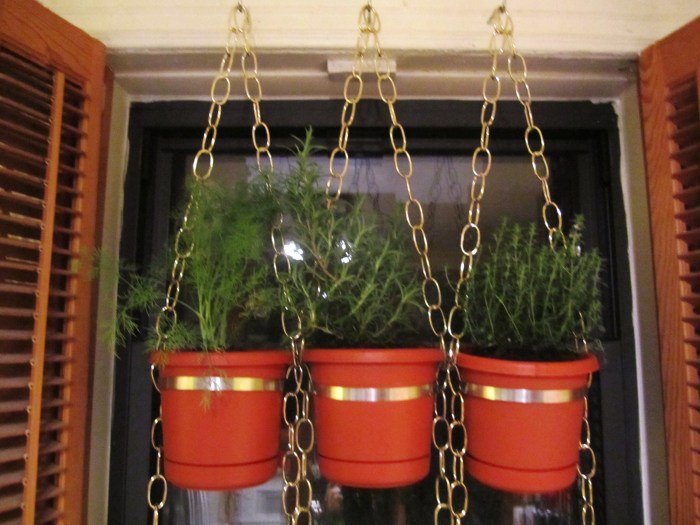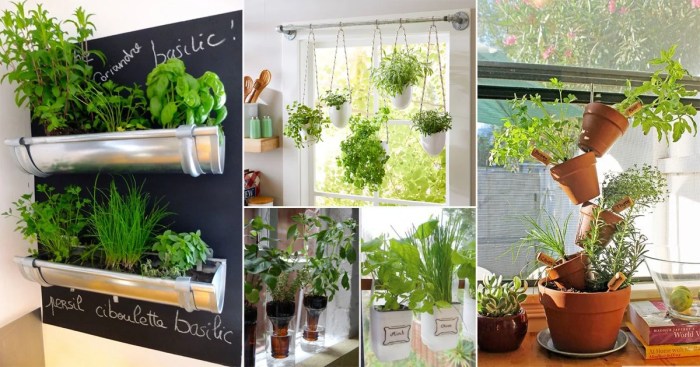Discover the joy of cultivating your own herbs with these 5 DIY hanging window herb gardens. Whether you’re a seasoned gardener or just starting out, these innovative designs will inspire you to create a thriving indoor oasis that will tantalize your taste buds and uplift your spirits.
From selecting the perfect herbs to designing and assembling your hanging garden, this guide provides step-by-step instructions and helpful tips to ensure your herbs flourish and bring a touch of nature into your home.
Materials and Tools

Creating a DIY hanging window herb garden requires specific materials and tools to ensure its stability and functionality. Understanding these requirements is crucial for a successful gardening experience.
Essential materials include:
- Pots:Choose lightweight pots with drainage holes to prevent waterlogging.
- Hanging brackets:Select sturdy brackets that can support the weight of the pots and plants.
- Soil:Use well-draining potting soil specifically designed for herbs.
- Drainage material:Gravel or pebbles can be placed at the bottom of the pots to enhance drainage.
Necessary tools:
- Drill:Required for creating holes for the hanging brackets.
- Screws:Secure the hanging brackets to the wall or window frame.
- Measuring tape:Ensures accurate spacing and alignment of the brackets.
Safety precautions:
- Wear safety glasses when drilling to protect your eyes from debris.
- Use appropriate drill bits for the materials you are working with.
- Secure the brackets firmly to prevent the pots from falling.
Plant Selection
Selecting suitable herbs for hanging window gardens is crucial for their success. Consider the light conditions available and the growth habits of different herbs.
Aromatic and culinary herbs, such as basil, thyme, and rosemary, are excellent choices due to their adaptability to limited space and their versatility in cooking.
Determining Plant Number
The number of plants to include depends on the size of the hanging garden. For smaller gardens, a few plants will suffice, while larger gardens can accommodate more variety.
Design and Assembly

Designing a hanging window herb garden involves careful consideration of pot spacing and arrangement to optimize plant growth and aesthetics. Position pots with adequate spacing to allow for proper airflow and sunlight penetration. Consider staggering the heights of pots to create visual interest and ensure that all plants receive ample light.To
5 DIY hanging window herb gardens offer a simple yet effective way to add a touch of nature and freshness to your home. For more inspiration on how to bring the outdoors in, consider exploring Different Types of Indoor Hanging Plants: Beautify Your Home with Nature’ . With its variety of options, you’ll find the perfect plants to complement your hanging herb garden and create a cozy, inviting atmosphere.
assemble the hanging brackets, follow the manufacturer’s instructions. Securely attach the brackets to the window frame using appropriate hardware. Ensure the brackets are level and can support the weight of the pots and plants.Optimizing drainage and airflow within the garden is crucial for plant health.
Creating a 5 DIY hanging window herb garden is a great way to bring the outdoors in and enjoy fresh herbs year-round. If you’re looking for more inspiration for hanging plants, Hanging Plants is a great resource for all things hanging plants.
From macrame hangers to ceiling planters, you’re sure to find something that fits your style and space. And once you’ve got your herbs growing, you can use them to add flavor to your favorite dishes or make your own herbal teas and tinctures.
Choose pots with drainage holes to prevent waterlogging. Place a layer of pebbles or gravel at the bottom of each pot to improve drainage. Ensure the pots are not overcrowded, as this can restrict airflow and promote disease.
Planting and Care: 5 Diy Hanging Window Herb Garden
Cultivating a flourishing hanging window herb garden requires meticulous planting and nurturing. Follow these guidelines to ensure your herbs thrive:
Preparing the Soil
Choose a well-draining potting mix specifically formulated for container gardening. Amend it with organic matter like compost or peat moss to enhance fertility and moisture retention.
Transform your windowsills into vibrant havens with 5 DIY hanging window herb gardens. These practical and decorative solutions bring the freshness of herbs right into your kitchen. From rustic macrame hangers to repurposed jars, the options are endless. For more inspiration on creating indoor green oases, explore our guide on Decorative Hanging Planters for Indoor Spaces: Enhance Your Home with Greenery . Discover how to elevate your interiors with lush greenery and create a serene atmosphere.
Filling the Pots
Fill the hanging pots with the prepared soil, leaving about an inch of space at the top for watering. Gently press down on the soil to firm it.
Planting the Herbs, 5 diy hanging window herb garden
Create small holes in the soil deep enough to accommodate the roots of your herb seedlings. Carefully remove the seedlings from their containers and gently loosen any circling roots. Place the seedlings in the holes and fill in the soil around them, pressing down gently.
Watering
Water your hanging window herb garden regularly, especially during hot and dry weather. Allow the soil to dry out slightly between waterings to prevent overwatering. To monitor soil moisture, insert your finger into the soil up to the first knuckle.
For those looking to bring the freshness of herbs into their kitchen, a DIY hanging window herb garden is a great way to do it. Not only does it save space, but it also adds a touch of greenery to the room.
If you’re looking for more inspiration on how to incorporate plants into your home décor, check out Decorative Indoor Plant Hangers: A Guide to Adding Style and Greenery to Your Home . With its tips on choosing the right plants and hangers, you’ll be able to create a beautiful and functional herb garden that will add life to your kitchen.
If it feels dry, it’s time to water.
Common Pests and Diseases
Hanging window herb gardens can be susceptible to common pests and diseases. Aphids, spider mites, and whiteflies are common pests that can damage herb plants. To prevent these pests, regularly inspect your plants and remove any visible insects. Diseases like powdery mildew and root rot can also affect herbs.
Ensure proper ventilation and avoid overwatering to minimize disease risk.
Decorative Touches
Elevate your hanging window herb garden’s aesthetic appeal with decorative touches. Experiment with colorful pots that complement your home decor, adding a vibrant splash to the space. For a rustic charm, paint or stain the hanging brackets to match the wooden window frames or walls.
Creative Accessories
Incorporate decorative accessories to enhance the visual appeal. Consider adding miniature wind chimes, birdhouses, or decorative hooks for hanging small plants or kitchen utensils. These touches create a whimsical and personalized touch to your herb garden.
Visual Harmony
Arrange the herbs and decorative elements in a visually appealing way. Group similar plants together for a cohesive look and stagger different heights to create depth. Consider the overall balance and symmetry of the arrangement to complement your home’s style.
Final Thoughts

With a little creativity and these DIY hanging window herb gardens, you can enjoy the benefits of fresh herbs year-round. Whether you use them to enhance your culinary creations, create soothing teas, or simply enjoy their aromatic fragrance, these vibrant gardens will transform your kitchen into a haven of flavor and well-being.
FAQ Guide
How often should I water my hanging window herb garden?
Water your herb garden when the soil feels dry to the touch. Avoid overwatering, as this can lead to root rot.
What are the best herbs to grow in a hanging window garden?
Basil, thyme, rosemary, oregano, and mint are all excellent choices for hanging window gardens.
How much sunlight do hanging window herb gardens need?
Most herbs need at least 6 hours of sunlight per day. If your window does not receive enough sunlight, you can supplement with grow lights.